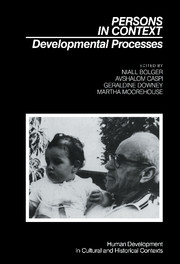Book contents
- Frontmatter
- Contents
- Preface
- Contributors
- 1 Development in context: research perspectives
- 2 Interacting systems in human development Research
- 3 Children, families, and communities: ways of viewing their relationships to each other
- 4 Human development and social change: an emerging perspective on the life course
- 5 Family process: loops, levels, and linkages
- 6 On the constructive role of problem behavior in adolescence
- 7 The sociogenesis of self concepts
- 8 Putting persons back into the context
- 9 How genotypes and environments combine: development and individual differences
- Author index
- Subject index
9 - How genotypes and environments combine: development and individual differences
Published online by Cambridge University Press: 04 May 2010
- Frontmatter
- Contents
- Preface
- Contributors
- 1 Development in context: research perspectives
- 2 Interacting systems in human development Research
- 3 Children, families, and communities: ways of viewing their relationships to each other
- 4 Human development and social change: an emerging perspective on the life course
- 5 Family process: loops, levels, and linkages
- 6 On the constructive role of problem behavior in adolescence
- 7 The sociogenesis of self concepts
- 8 Putting persons back into the context
- 9 How genotypes and environments combine: development and individual differences
- Author index
- Subject index
Summary
Not long ago, most psychologists thought that the major purpose of their research was to discover eternal laws about human behavior – laws that applied in principle to all of the people all of the time. At the same time, a smaller group of psychologists focused their research on individual variation in people's responses to events in their lives-that is, on individual differences. The history of the two orientations can be traced to what Cronbach (1957, 1975) called “the two disciplines of scientific psychology” – to wit, research on species-typical or average trends in human behavior, and research on individual differences. Today, the two disciplines are merging in new theories based on concepts about the ways in which people are both typically human and uniquely so. In a fine paper, David Buss (1984) outlined the distinctive features of the two disciplines of scientific psychology, which, following Ernst Mayr (1963), he called“typological”and “population”approaches, as shown in Table 9.1. The former is concerned primarily with painting the human species in broad strokes, the latter with detecting fine variations within the species.
Psychology's two scientific disciplines, to use Cronbach's terms, have their parallel in Mayr's contrast of typological and population approaches in biology. The former is philosophically Platonic; although there are variations within species, these are considered merely imperfect versions of the ideal type. What is important is to understand the true nature of the species, the ideal.
- Type
- Chapter
- Information
- Persons in ContextDevelopmental Processes, pp. 217 - 244Publisher: Cambridge University PressPrint publication year: 1989
- 3
- Cited by

